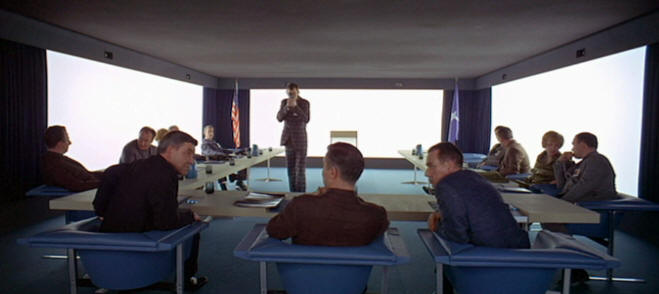
“Kubrick: and beyond the cinema frame”
An in-depth analysis of
2001: A SPACE ODYSSEY
Text copyright © by Rob Ager 2008
(last updates added 2015)
CHAPTER 5
JUPITER AND BEYOND THE CINEMA FRAME
Now we’re moving into territory that is virtually unique in cinematic history – the notion of on screen characters realizing that their own universe is nothing more than a two dimensional cinema screen. An email respondent to my first review of 2001 pointed out that when Heywood Floyd holds a council meeting with his colleagues the horizontal monolith is depicted on all four walls of the room, but in pure white. As it turns out this observation of white monoliths is another conceptual key that unlocks even more of the film’s hidden narratives. For example, if we look closer at the meeting room set we find that these strange illuminated walls are flanked by curtains, just like plain white cinema screens are.

Now if we go back to the stargate shots we find yet another clue that the monolith is a cinema screen. At the end of the tunnel the screen begins to fill up with bright white light then the shot cuts and we see a human eyeball which has been superimposed with colour. If the shot had not cut away then the stargate would have filled up the entire screen with pure white, leaving Bowman and the audience staring at an empty screen. This would have made the visual connection to the cinema screens of the council meeting much easier to notice.
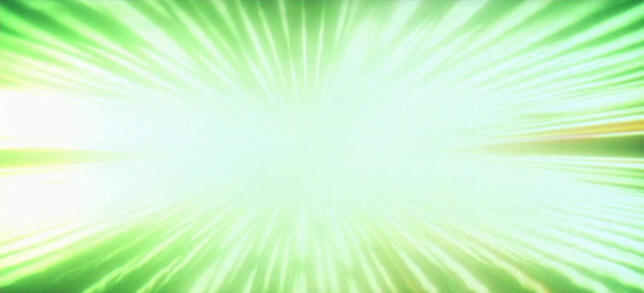
It has widely been perceived that Bowman’s stargate journey takes him to another dimension and indeed it does, but now we can explicitly recognise what that alternative dimension is. By gaining awareness of the monoliths true meaning Bowman is leaving the two dimensional confines of the screen and becoming part of his own audience … hence he begins seeing himself in the third person in the renaissance room.
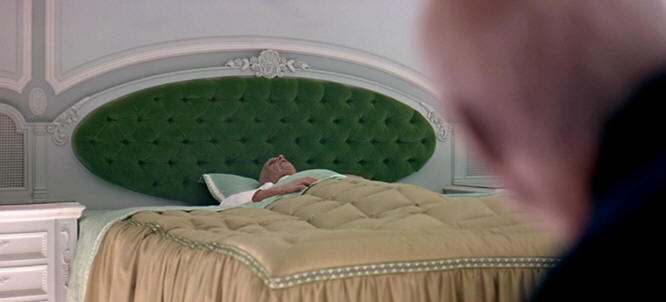
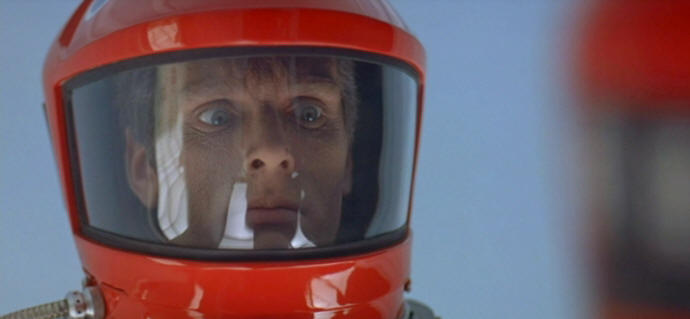
A very clever visual trick communicating this theme is that when Bowman looks at himself in the bathroom mirror, the close up of his reflection reveals that the glass in his helmet is reflecting not the bathroom, but the bedroom. He now has the ultimate in self awareness. He knows he is a character in a movie.A very nice production photo shows Bowman in a doorway, precisely half hidden by a door. Again he is half in and half out of the film.
And another two photos show him viewed first from inside the pod, but the position of the pod is in the corner of the room, where it would not be able to physically fit. The second shot is almost identical, minus the pod window framing, and reveals that Bowman is looking at his own film crew.

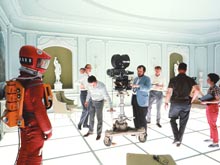
Perhaps it was the crew that he was staring at in the film with a confused look on his face.

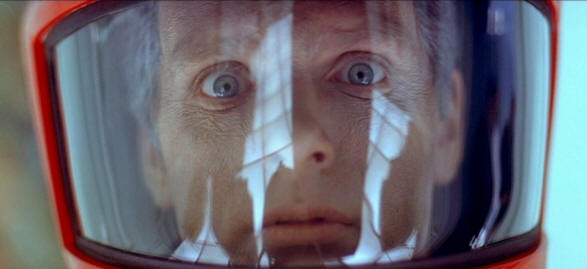
The psychedelic patterns of the stargate represent the colours and pigments being drained from the cinema screen to reveal the empty white surface that audiences are faced with when they first sit down. One of my email correspondents has also noted that Bowman may be looking out of the cinema screen and directly into the projector lens. This shift to the universe outside the film is such a terrifying paradigm shift for Bowman that by the time he reaches the renaissance room he is trembling with shock. When the apes feel the edges of the monolith they too are gaining a similar awareness of a third dimension – the dimension of depth.
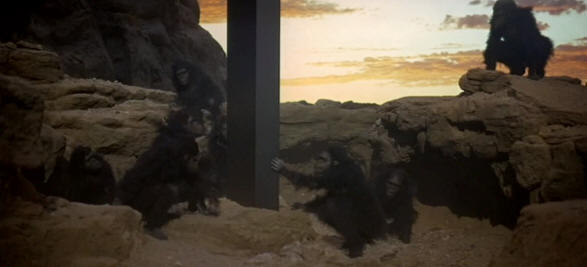
This also explains the caption “Jupiter and beyond the infinite”. The on screen universe appears infinite, but to step beyond it we need only look beyond the edges of the screen.The film within a film concept is cleverly embedded in the two AE-35 replacement scenes near the Discovery ship antenna. The camera angles used to show Bowman’s short voyage in the pod and his space walk toward the antenna are repeated when Poole attempts the second trip.
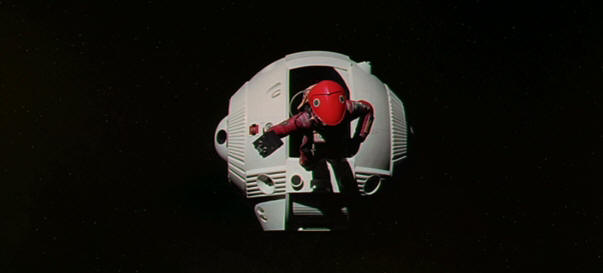

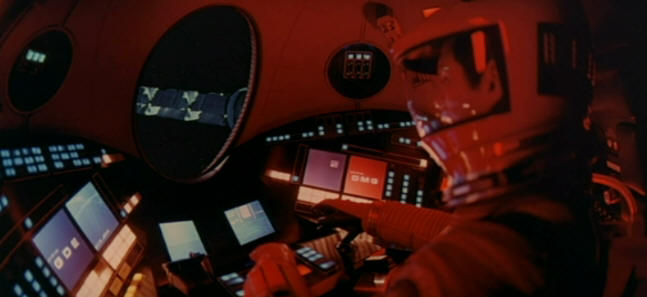

The difference is that these same camera angles are now presented on the cockpit computer screens. It’s as if they have become the viewpoints of HALs surveillance cameras. So if we ignore the colour differences between the two astronauts suits then Bowman is basically seeing himself. He is in and out of the film. The heavy breathing that we hear over the two spacewalk scenes, which also repeats when Bowman arrives in the renaissance room, again suggests that the astronauts are both in front and behind the camera. A stronger visual clue that we are watching a film within a film, and that sometimes we are shifting in and out of different narratives, can be found when Poole and Bowman first enter the pod bay. The camera pans with them as they walk through a doorway and reappear behind a glass window. The frame of the window matches up with the screen and the shot is repeated as Bowman rushes to the pod bay after Poole is murdered. Remember that the idea of a monolith floating in from the right to match the cinema frame was shown on the digital screens of the moon bus cockpit.
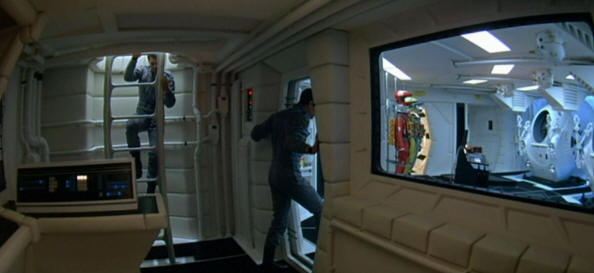
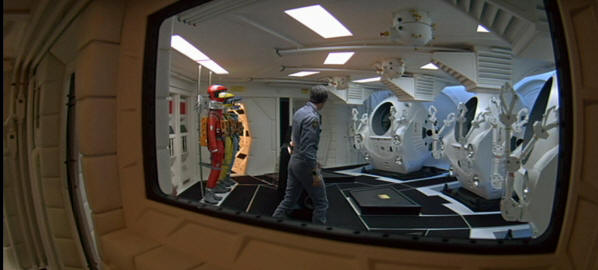

One email recipient wrote to me with a thesis that the monolith could also represent the golden rectangle - a geometric shape that can be rotated 90 degrees and shrunk to fit within itself infinitely.
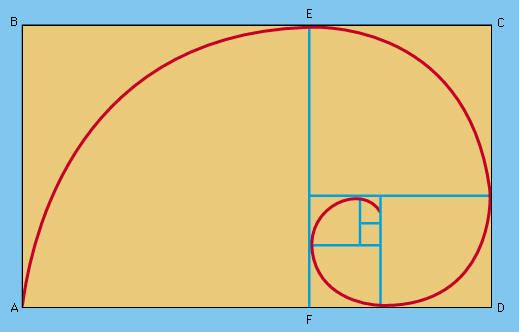
I haven't found many images in 2001 that fit with this concept apart from the green pattern on the left of the stargate shown below.
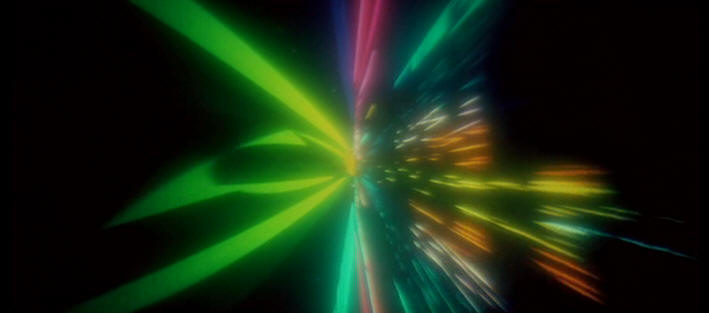
The pattern appears to be a series of curved arrows that infinitely rotate into each other at 90 degree incriments. I noticed it when viewing flattened out images that had been extracted from the stargate patterns by another researcher. Here is the section that caught my attention.
Paralleling this films within films or fractal movie theme, is the concept of video feedback. This occurs when a video camera is connected to a monitor and then put in record mode while filming that same monitor.
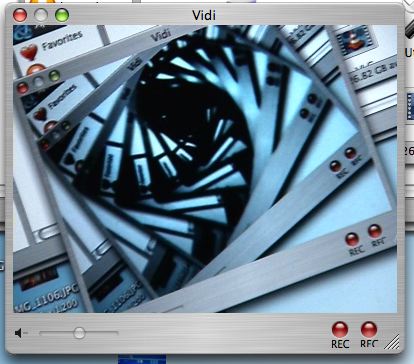
Another example of this paradigm in 2001 can be seen in the screen shot below. Look at the three small screens in the lower left. The one in the centre displays a view of the landing craft that is identical to what we are already seeing in the larger view. The presence of multiple monolith shaped windows showing different rooms only serves to enhance this multiple reality encoding.
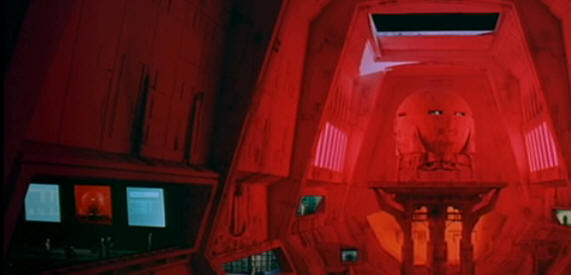
There is also a phenomena called audio feedback that occurs when a live microphone is placed near its own speaker, resulting in a high pitched sound. We hear this kind of high pitched whine emanating from the monolith after the apes recognise its meaning and again with the astronauts in the excavation pit. And after the slitscan patterns of the stargate white out the screen and cut to a colourized eye, the music turns to a high pitched whine before the explosion of consciousness. This all fits perfectly with the monolith being a cinema screen. By recognising the black box's meaning our awareness of the film shifts into a fractal feedback loop.It’s worth noting that black and white monoliths filmed at various angles, and sometimes rotating, are built into many of the sets. For example the eye of HAL is boxed in a black vertical monolith and Poole’s chess game is projected on a black horizontal monolith.

The true meaning of the monolith has been staring us and the fictional characters directly in the face throughout the whole film, just begging to be noticed. A hilarious example is that when eating on the discovery Poole and Bowman are watching themselves on tv screens that have been rotated 90 degrees. There is no reason to assume that television screens of the future will be longer than they are wide, but in 2001 they are shown in both orientations.
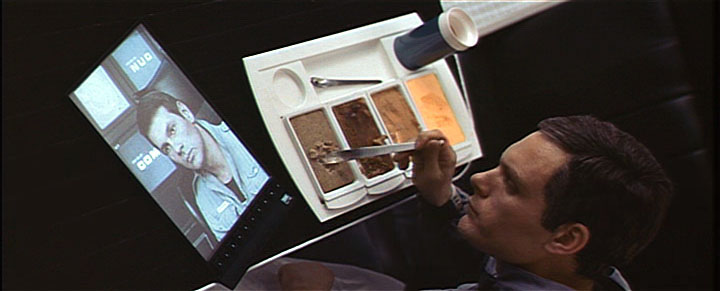
It’s also possible that Kubrick designed certain set elements as a metaphor of the actual film reel. The spinning Torus station is featured on the most famous promotional poster for 2001 and is thus central to the film’s meaning.
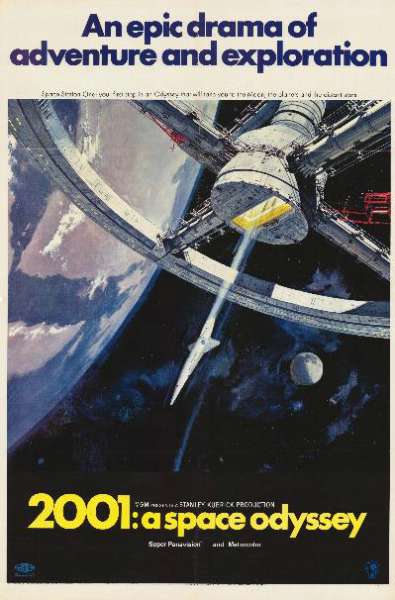
It has two rings and the side which is under construction features a wire frame. For some reason the poster is a painting rather than a production photo and an important detail is that in different versions of this same poster the docking bay is either yellow or red, but in the film it is white. The planet in the background also changes colour on different posters, but we'll explore these colour variations in more detail in later chapters.

So could it be that the Torus station represents a film reel within a film and that the docking bay is the projector?
Notice also that as the Pan Am ship enters the Torus station it first has to align with the monolith shaped docking bay, which is featured on the Pan Am ships computer display as a rotating wire frame monolith. The aligning of spaceships also parallels the aligning of Jupiter and its moons.
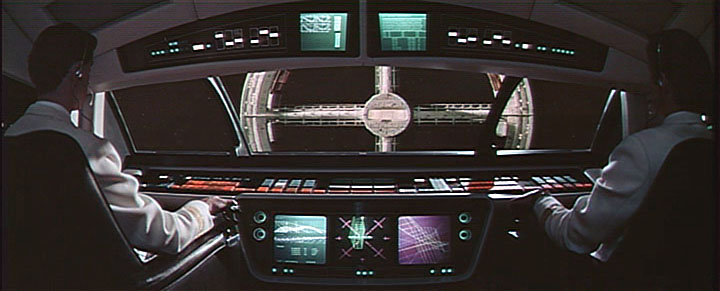
Tying in with these themes we find that virtually all of the satellites and spacecraft that we see before the Torus docking sequence appear very flat, as if they are being projected onto the film. Their angles and lighting do not change and their shadows often completely mismatch the light sources suggested by how the Earth and moon are lit. It’s as if they are merely still photos being projected onto the film. This is also true of the lunar landing shots. The lunar lander seen descending toward the moon surface is shown with the Earth in the background. These two spherical bodies should be equally lit if the sun is the light source, but the Earth is almost fully lit from the front, while the lander appears lit from further in the distance.
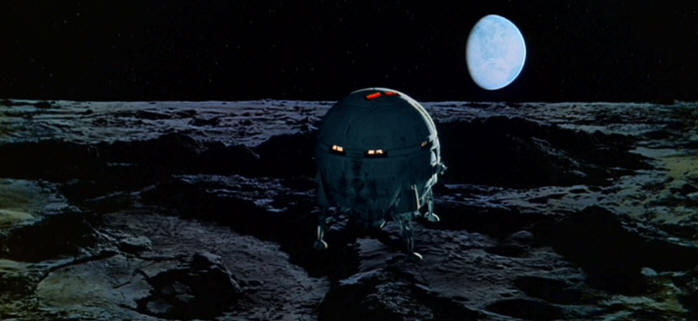
One could argue that special effects were limited in 1968, but the magnificent spinning Torus station and Discovery ship prove otherwise. The spinning of the monolith near Jupiter with its changing surface reflections only serves to exaggerate the two dimensional look of the satellites in Earth orbit. The final shot of the Torus docking sequence features the two wheels of the station rolling toward the camera until they disappear off screen leaving a black emptiness. It’s as if we are entering or exiting a film reel.
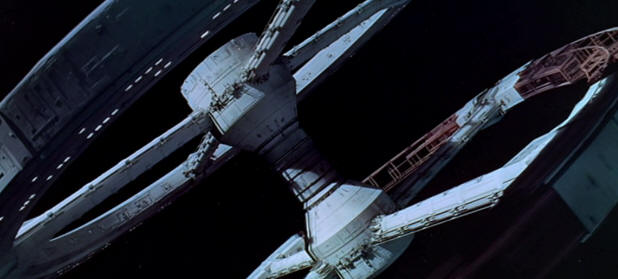
We now cut to a shot of Floyd emerging from a strange rotating seating area. Though we don’t get to see it very well in the film, the following production photo shows the outside of the rotating seating area. Does it not look like a strip of film frames?
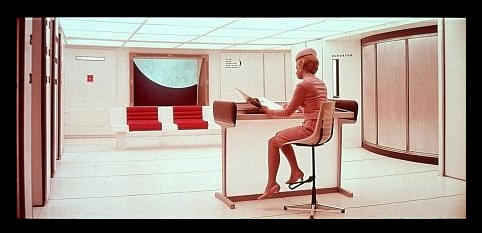
The following selection of posters show assorted scenes from 2001 occupying the central strip of the image with the main promotional painting of the Torus station as a background filler. This is an interesting combination, which could again be implying a film with a film.
The living quarters of the Discovery also rotate like the Torus station and from many angles we can see that a band of light shines down on the computer consoles from each wall.
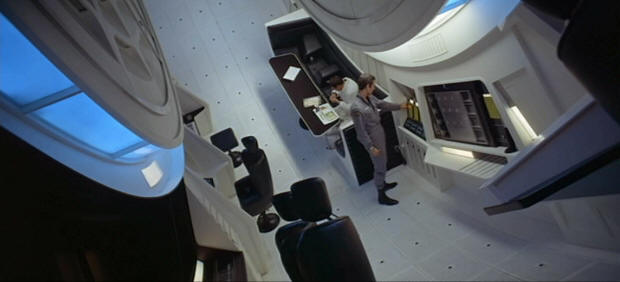
The light forms a continuous circle around both sides of the set and is divided up into sections whose dimensions match the the individual frames of a widescreen cinema reel. Now I’m not claiming that this film reel interpretation is conclusive, but it certainly fits with the other themes in this review. There are also other set design features that gain new meaning when compared with the technicalities of the film process. 2001 was shot in 70mm Cinerama format. This was an extra wide screen format developed by the studios in competition with the television industry. The finished film is divided into three strips and projected onto a curved screen by three synchronised projectors.
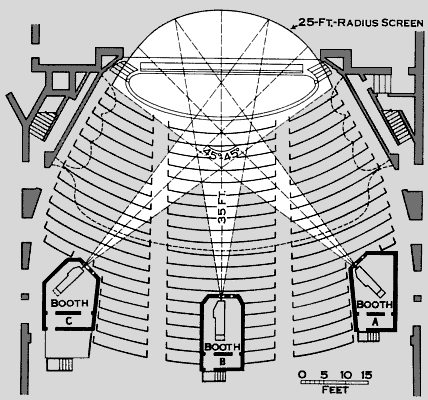
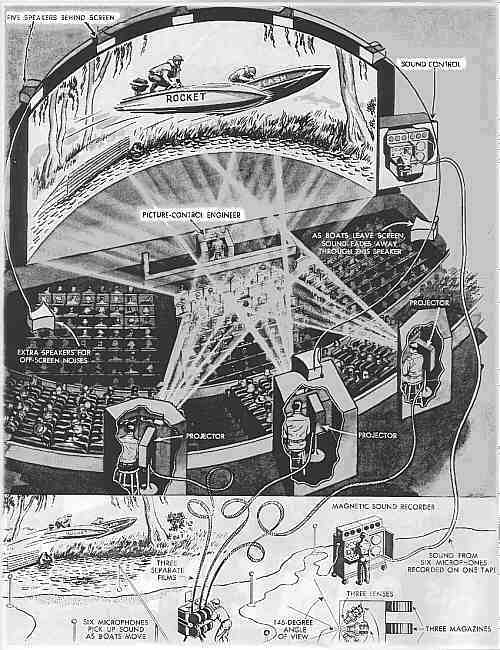
The format never really caught on and so most of us have never watched 2001 in its original format. Nevertheless, Kubrick seems to have incorporated aspects of the Cinerama projection equipment into his sets. Many shots, including HALs vision, are shot with panoramic lenses and the lenses and cameras were provided by a company called Panavision. The concept of three cinema screens displayed side by side in a slightly curved arrangement can be seen in the council meeting room, the square floodlights of the lunar excavation site and the shot of Floyd watching the approaching moon surface in the lunar landing craft.

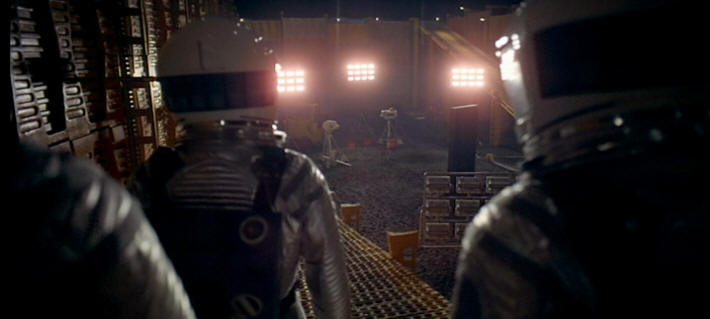
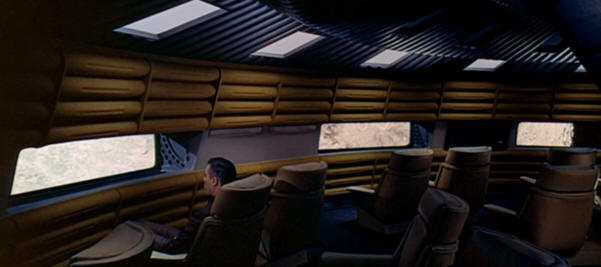
The excavation site also doubles up as a symbolic movie theatre. The astronauts walk down a ramp with the intention of viewing the monolith, just as audiences walk down movie theatre isles in order to view a cinema screen. The photographer taking pictures of the monolith tilts his camera 90degrees between taking photos, encouraging us to rotate our view as well. Floyd reaches his hand out and simultaneously touches both the monolith and the rectangular lens flare from one of the floodlights.
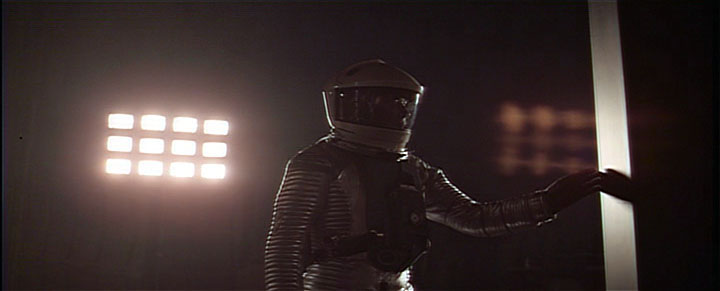
As the astronauts gather for their group photo we see the monolith positioned in between two floodlights at the back of the excavation site, which together comprises the triple projection of the Cinerama film format.

As the photographer steps backward, the camera movement causes the rectangular lens flare behind him to match up with the floodlight. At this exact moment of alignment the monolith gives off its ear piercing signal – the screen connection has been made.
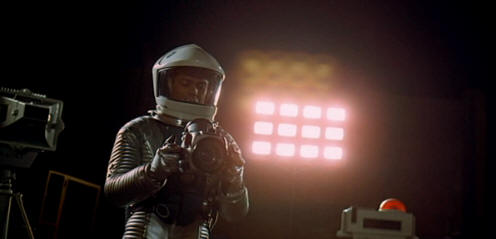
Another curious set design element, that seems to have several implications, is the space pods inside the discovery. It seems unnecessary to have three of these pods, each with its own separate door, but looking at the ceiling above them we find arrangements of three monolith shaped white lights, as well as a black widescreen shaped computer console, which the three pods are facing. The sides of these pods also feature designs similar to film reels so this could again be a depiction of the Cinerama triple projectors.

Now another important aesthetic theme of 2001 is the disorientation caused by zero gravity. This not only adds realism to the space scenes, but it also ties in with the idea of characters being confined within the technicalities of a film reel. As with virtually all forms of photography, images passing through a camera lens are turned upside down and left to right before they are burned into the celluloid.
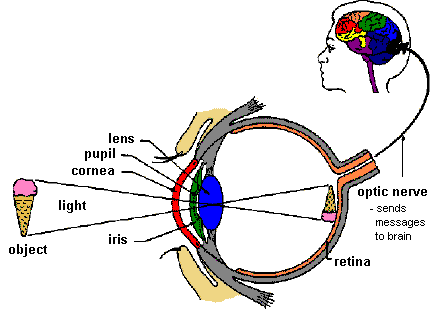
The Discovery ship may have been designed with this in mind.
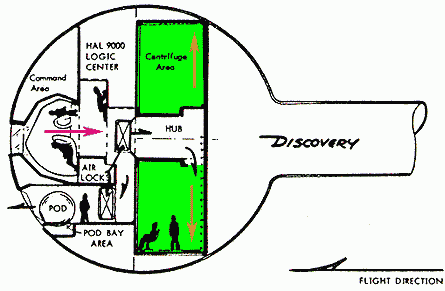
So we find the characters of 2001 frequently battling with a lost sense of orientation. I know this sounds obscure, but if you indulge me for a few moments you may find the concept much more plausible. Watch the shots of Frank Poole as he runs around the rotating living quarters of the discovery. From the positions of the three crew members in hibernation we can tell that in some of the shots Frank is running in reverse directions.
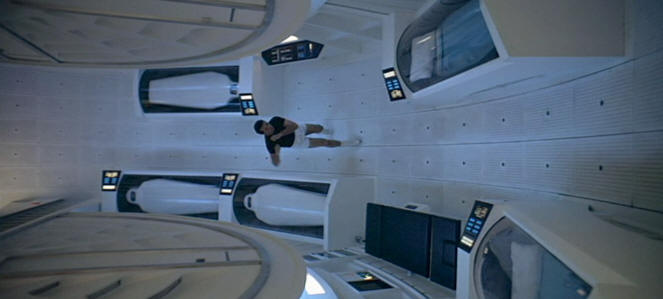


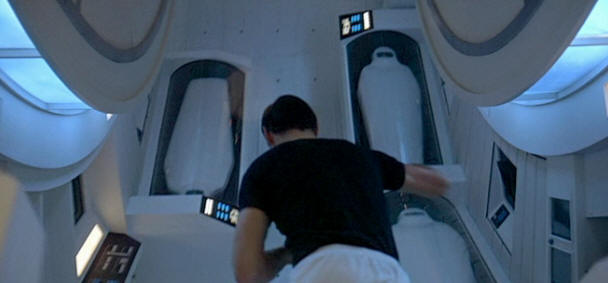
Now of course even a perfectionist like Kubrick is capable of continuity errors, but this visual error is only possible in three ways. Either ...
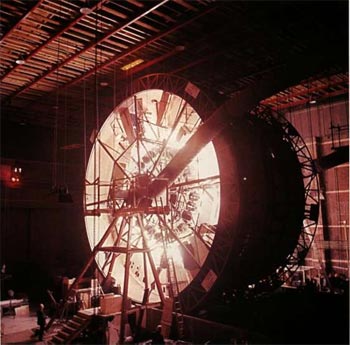
None of these three possibilities could plausibly have occurred by accident. In fact close examination of the shots shows that Frank is filmed with the wheel spinning the opposite way and the shot was also flipped horizontally in the edit. And here’s another clue that the mistake was deliberate. Bowman is shown sketching his views of the hibernation beds and comparing his drawing to what he actually sees in front of him.
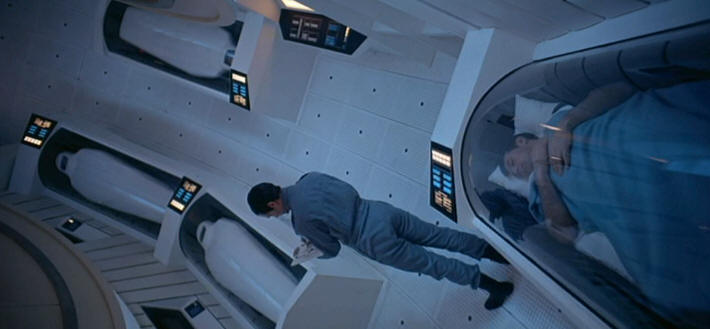
Another example of seemingly deliberate disorientation can be found as the egg shaped craft flies Floyd to the lunar surface. One shot shows the craft moving down screen toward the lower end of the moon, but the next shot flips the scene upside down and left to right so that the craft is now headed upward.
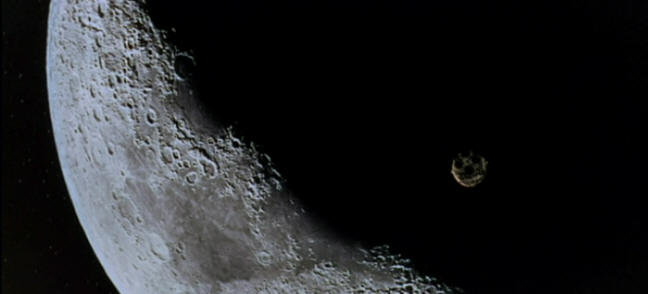

How could this continuity error possibly have gone unnoticed during the edit? There are actually many visual errors along these lines. The bone thrown into the air by the ape is spinning anti clockwise as it goes up, but comes back down spinning the other way. The shot of the aligned Torus station, as seen through the Pan Am craft cockpit, shows the station with a fixed light source, but due to the spin of the station this light source should actually be rotating around the station. The light shining upon the two pilots is also coming from a different direction.

The cockpit shot from inside the discovery with Bowman’s space pod seen directly outside, also has two conflicting light sources. The pod is lit from one side but the shadows inside the window are coming from the opposite direction.
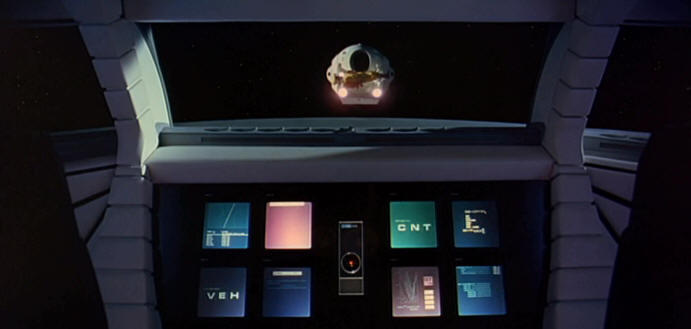
These examples could be genuine errors, but the following examples of confused orientation are much more reliable. HAL tells Poole and Bowman that a device called the AE-35 unit is about to fail and that they must replace it. The exact function of this so-called AE-35 unit is not explained to us, though we do see its partially dismantled contents being tested by Bowman. During my research I found a webpage called www.2001spacesuit.com. The creator of this site had found out what the AE-35 was. It is a mechanical device for measuring orientation, called a gyroscope. Here is the real life gyroscope that the webpage author had stumbled across …
... and here is the one featured in 2001.
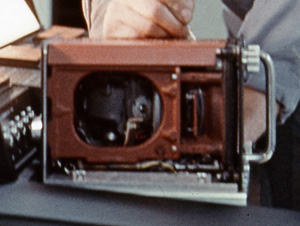
So unless this is an incredible co-incidence it would seem that the failure of the AE-35 unit would effectively mean a failure in the discovery ships sense of orientation. The computer display of the AE-35 unit also features a super-imposed rotating rectangle. The word "align" appears in the lower portion of the image data.
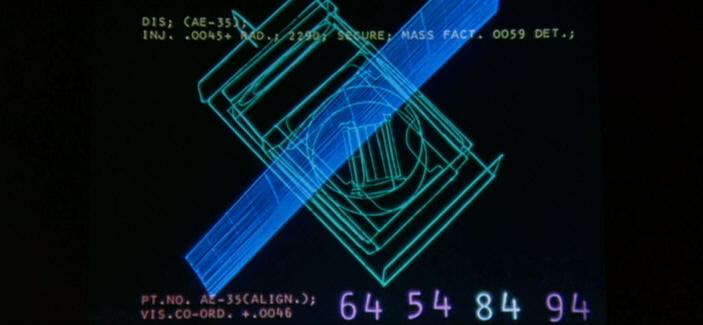
Continuing with the disorientation theme, several production stills and posters for 2001 feature images from the film that have been flipped vertically or horizontally.
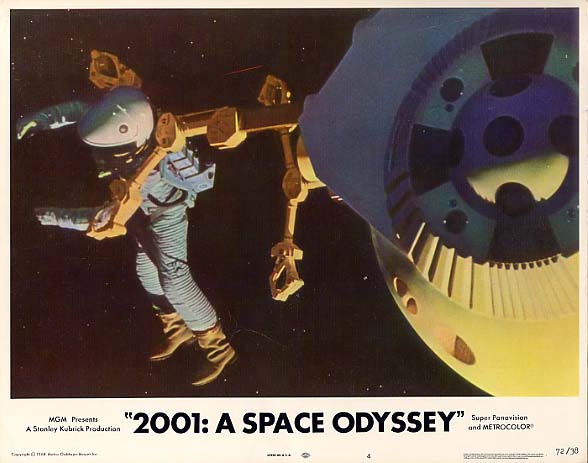

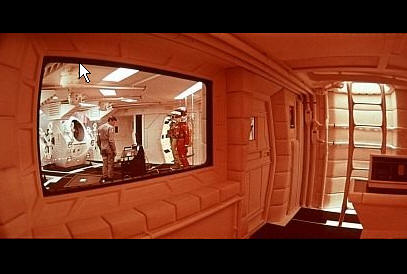

Another reliable example of confused orientation can be found in the Torus station’s illuminated ceiling tiles. As Floyd converses with his associates he asks “where are you all off, up or down?” and when Bowman arrives in the renaissance room these ceiling tiles now appear as a floor design.

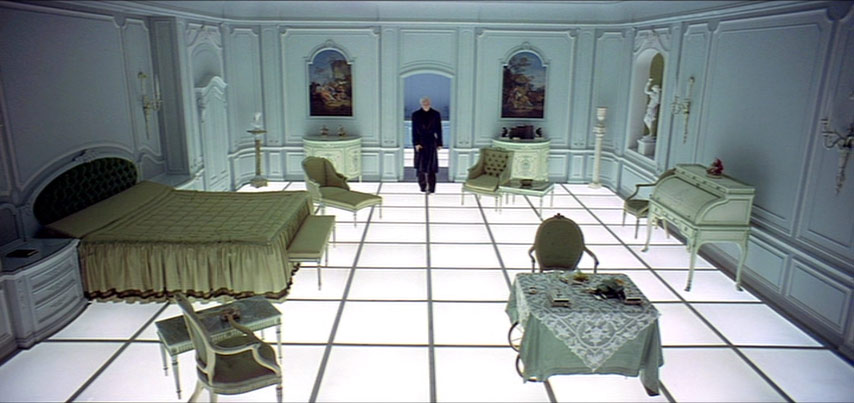
While on the subject of these two scenes I’d like to point out that Floyd refuses to have a drink and says he’s off to have breakfast. Bowman on the other hand does have breakfast and a drink. He considers the glass and its contents carefully, drinks up and then eats some of his food. The next moment, when he accidentally smashes the glass, has received many interpretations, but one thing we can be sure of is that it represents some sort of change that enables Bowman to take the next step in his evolution. After looking at the glass he sees himself dying on the bed and ready to be reborn, but what is it about the breaking of a glass that is so significant? Several months ago I received a fascinating email on the subject, which I think makes the shot easier to understand. The email was from a man named Matt Pulver and it read as follows:
"Sometime in the 1990's they had released the original 70mm film in Hollywood for a short period of time and I and my girlfriend went to go see it. One thing happened in it that I wanted to share with you. At the moment the wine glass shatters near the end of the film, the film itself noticeably skipped, like the physical film reel was damaged. In the theatre I immediately laughed, because knowing Kubrick this was not a mistake. It goes beautifully with the interpretation that there are moments in the film where we are staring at nothing other than the actual monolith itself (the screen.) By having an error occur in the film on 2 levels at once, it's the film trying to step out of itself, a theme which is intimately tied in with the nature and mystery of consciousness, which I speculate that Kubrick was trying to express."
If Matt’s observation about the 70mm print is true then this deliberately placed technical error must have been removed from the edit when the film was transferred to the industry standard 35mm format. So taking into mind the other themes described in this review, my interpretation of the shattered glass is that Bowman, after observing and drinking the wine, has been “chewing” over the films meaning, just as we have. His accidental breaking of the glass and the simultaneous “skipping” of the film reel is a symbol that Bowman has finally broken the film’s visual code. Now he is ready to be reborn and return to the cinema screen universe from which he came. The POV shot moving forward into the monolith pushes the image of the set away on either side like a set of cinema screen curtains.
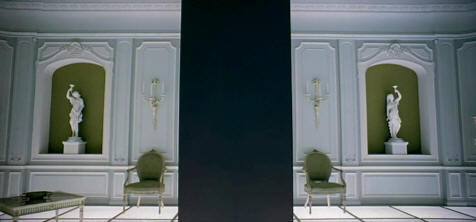
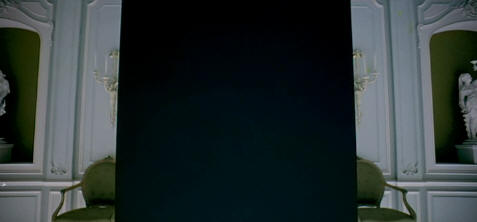
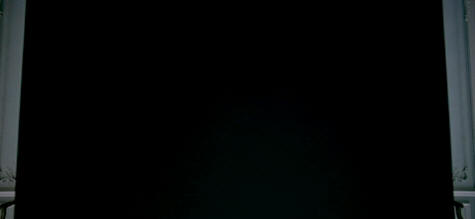
The glass smashing shot may also be paralleled in the shot of the ape staring inquisitively at the skull before smashing it with a bone. Perhaps this is the ape cracking the film code too.
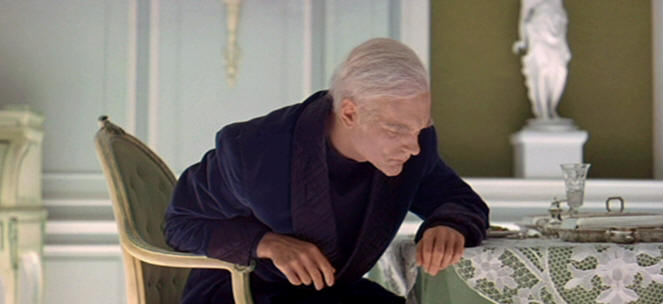
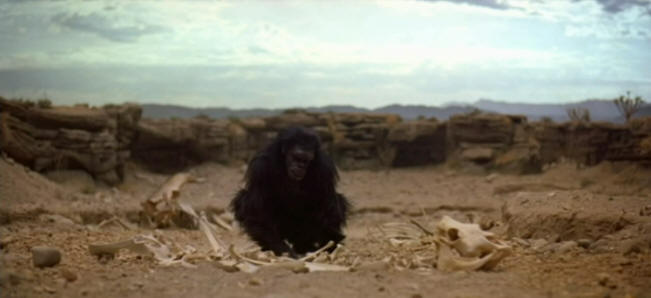
It’s worth noting that the primates would also have a flat earth mentality. So the enlightenment themes may include awareness of gravity just as it gives Bowman a sense of orientation.